
Research Results
ICT Application and Integration by Pre-service Teachers Beginning to Implement the IMYM Model
Prepared by Distance Learning and Information Technologies Unit, Program Development Branch, Manitoba Education and Early Childhood Learning
Analysis of Pre-service Teachers' Self-reported Pedagogical Skills in Integrating ICT
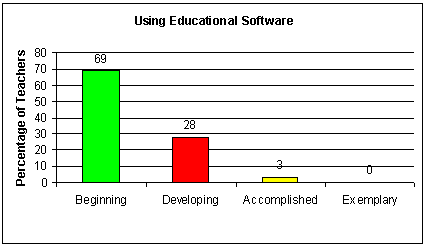
Nearly one third of pre-service teachers (31%) place themselves at either the Developing or Accomplished level of educational software use (see Appendix B Part I). These teacher candidates use educational software during their student-teaching practicum as an instructional supplement or to provide experiences otherwise unavailable to students. However, more than two thirds of pre-service teachers (69%) do not use educational software as part of their instruction and are not aware of any titles that may help students meet their learning goals.
Using ICT to Improve Student Writing
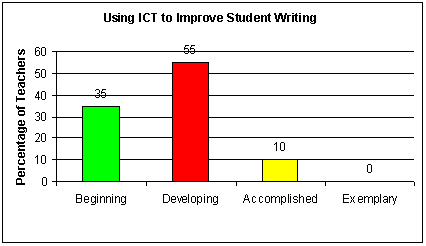
Thirty-five percent of pre-service teachers identify themselves at the Beginning level for using ICT to improve student writing (see Appendix B Part II). These preservice teachers are not familiar with any technologies that would allow them to help students improve their writing skills. More than half of teacher candidates (55%) ask that some student-writing assignments be word-processed except for composing or editing their writing directly on the computer (Developing level). During their student-teaching practicum, ten percent of the pre-service teachers help students use the computer in all phases of the writing process. They also use technology to help students share their work with a wide variety of reading audiences (Accomplished level).
Teaching Information Literacy Skills using Resource-Based Learning
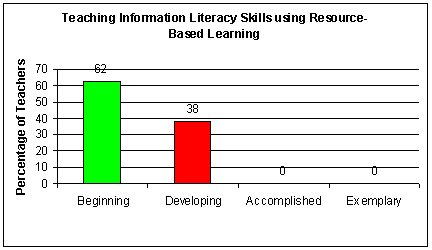
Almost two thirds of pre-service teachers (62%) place themselves at the Beginning level of teaching information literacy skills using resource-based learning (see Appendix B Part III). These teacher candidates are not familiar with the term information literacy and do not yet know why such skills are important. The remaining pre-service teachers support library skills taught by the teacher-librarian and are using resource-based learning (RBL) during their student-teaching practicum. They are also aware of the variety and quality of electronic resources available to their students(Developing level).
Teaching Information Literacy Skills using Primary Sources
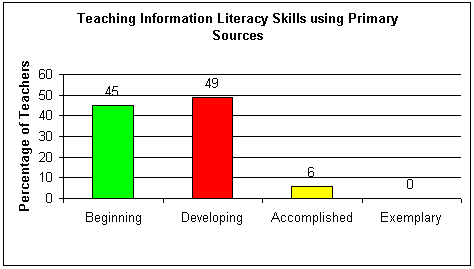
During their student-teaching practicum, forty-five percent of pre-service teachers expect their students to do research using only secondary resources such as books, magazines, or reference materials (Beginning level) (see Appendix B Part IV). Half of the teacher candidates (49%) place themselves at the Developing level for teaching information literacy skills using primary sources. As part of their instructional strategies, they include student projects that require collection and analysis of original data. These pre-service teachers can generally predict the outcome of their students' experiments or surveys. However, only 6% of pre-service teachers report that they teach their students how to use spreadsheets and databases to record, organize, analyze, and communicate their collection of original data (Accomplished level).
Modifying Instructional Approach
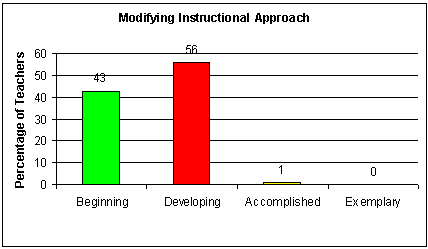
During their student-teaching practicum, forty-three percent of pre-service teachers rely on only one or two effective methods of delivering content to their students and do not use any technology that would require them to change their instructional methodology (Beginning level) (see Appendix B Part V). Over half (56%) of the teacher candidates place themselves at the Developing level of skill at using technology to modify their instructional approach. These teachers have initiated units or projects that have a technology component, but most use of technology by their students takes place in a computer lab and not directly in the classroom.
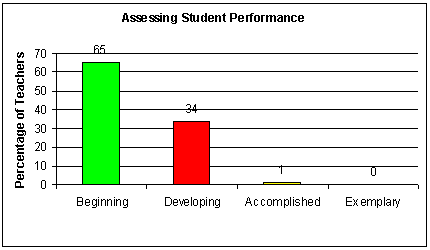
During their student-teaching practicum, two thirds of pre-service teachers evaluate their students' knowledge using objective written tests only (Beginning level) (see Appendix B Part VI). One third of the pre-service teachers place themselves at the Developing level for assessing student performance. These teacher candidates evaluate some student performances or projects using subjective as well as objective criteria. They also print copies of electronic work such as word processed documents, graphics and presentations to include in portfolios for student/parent/teacher conferences.
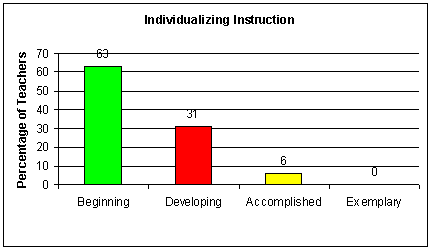
Almost two thirds of the pre-service teachers (63%) modify their instructional strategies only for students with identified special needs (Beginning level) (see Appendix B Part VII). One third of teacher candidates place themselves at the Developing level for individualizing instruction. At this level, during their student-teaching practicum, these pre-service teachers occasionally give students a choice of assignments. However they believe all students in their class (unless in a modified program) must achieve the same learning outcomes within the same time frame. These preservice teachers also do skill remediation with students using technology during or after school.
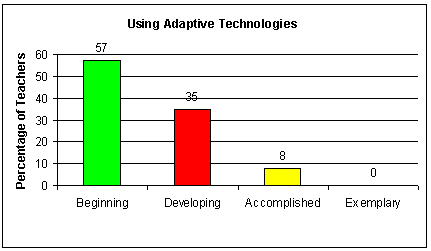
Almost two thirds of pre-service teachers (57%) indicate that they are not aware of how technology can help students with physical or mental challenges (Beginning level) (see Appendix B Part VIII). One third of teacher candidates identify themselves at the Developing level for using adaptive technologies. At this level, they can work with students who may bring special devices with them to work and communicate in the classroom.
Using Technology for Professional Learning and Communication
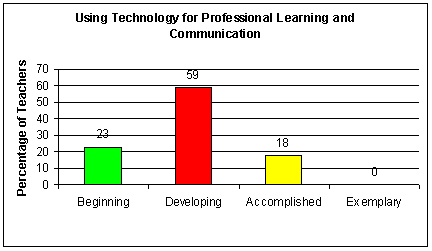
Most of the pre-service teachers (59%) place their skills at using technology for professional learning and communication at the Developing level (see Appendix B Part IX). During their student-teaching practicum, these teacher candidates can find lesson plans and educational research online. They also correspond with parents and other teachers using email. Of all the 10 pedagogical skills surveyed, the use of technology for professional learning and communication has the highest rating (18%) at the Accomplished level for pre-service teachers.
Researching and Evaluating the Use of ICT in Education
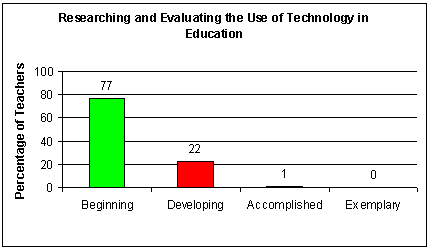
More than three quarters of the pre-service teachers (77%) identify their skills to be at the Beginning level for researching and evaluating the use of ICT in education (see Appendix B Part X). This is the highest rating at the Beginning level for any of the pedagogical skills rated. These teacher candidates indicate that they have not yet attempted to determine when the use of ICT during their student-teaching practicum has made a difference in their students' learning or in classroom climate nor how to find out if ICT is effective in their classroom. The remaining pre-service teachers indicate they are collecting, using, and sharing with colleagues, anecdotal information and their observations of their students using ICT in the classroom during their student-teaching practicum (Developing level).


